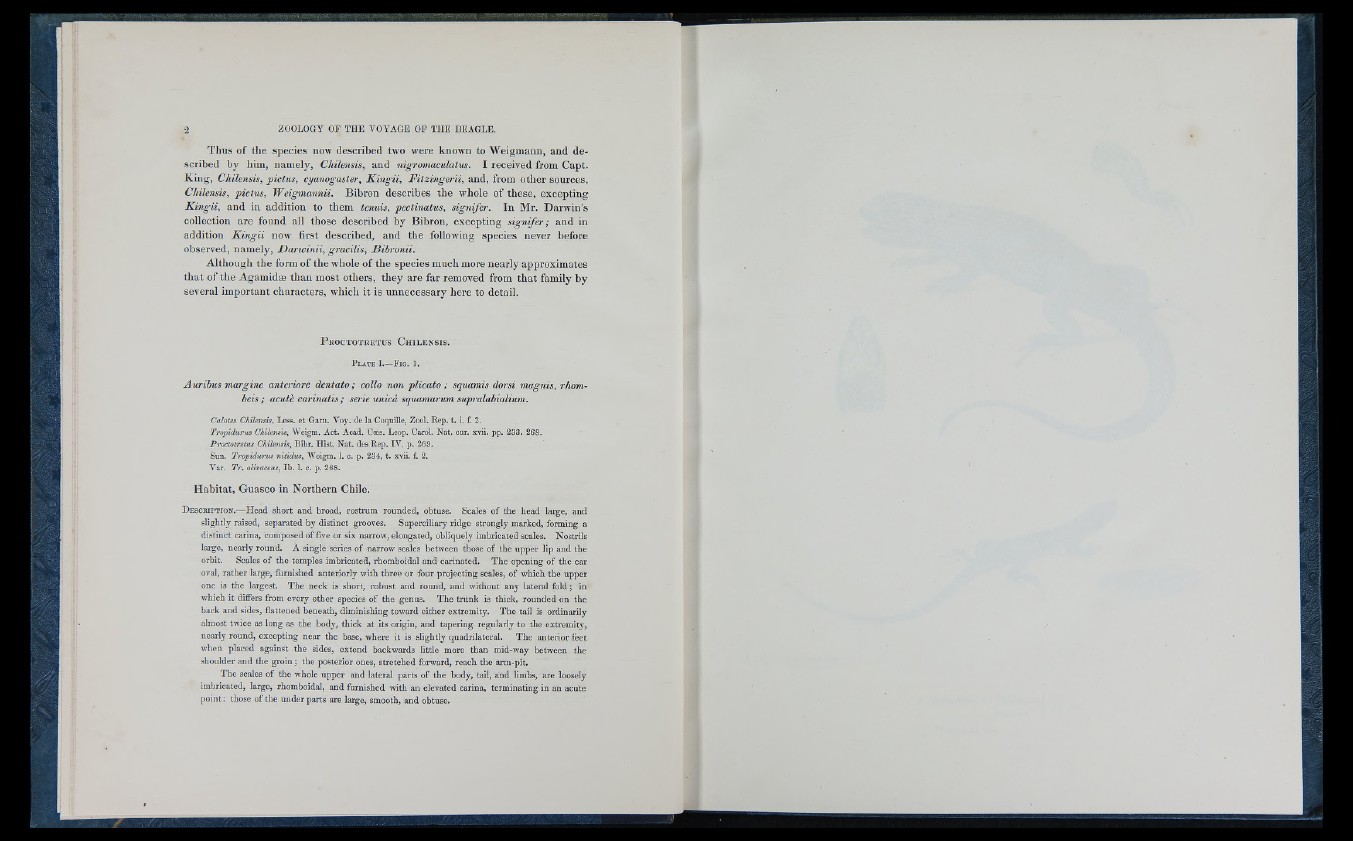
Thus of the species now described two were known to Weigmann, and described
by him, namely, Chilensis, and nigromaculatus. I received from Capt.
King, Chilensis, pictus, cyanogaster, Kingii, Fitzingerii, and, from other sources,
Chilensis, pictus, Weig'mannii. Bibron describes the whole of these, excepting
Kingii, and in addition to them tenuis, pectinatus, signifer. In Mr. Darwin’s
collection are found all those described by Bibron, excepting signifer; and in
addition K in g ii now first described, and the following species never before
observed, namely, Darwinii, gracilis, Bibronii.
Although the form of the whole of the species much more nearly approximates
th a t of the AgamidfE than most others, they are far removed from that family by
several important characters, which it is unnecessary here to detail.
P r o c t o t r e t u s C h i l e n s i s .
P l a t e I.—F ia . 1.
A uribxis margine anteriore dentato; collo non plicato; squamis dorsi magnis, rhom-
beis i acuth carinatis; serie unicd squamarum supralabialium.
Calotes Chilensis. Less, et Gam. Voy. de la Coquille, Zool. Rep. t. i. f. 2.
Tropidu7-iis Chilensis, Weigm. Act. Acad. C®s. Leop. Carol. Nat. cur. xvii. pp. 233. 268.
Proctotretus Chilensis, Bibr. Hist. Nat. des Rep. IV. p, 269.
Sun. Tropidurus niiidus, Weigm. 1. c. p. 234, t. xvii. f. 2.
Var. T r . olitaceus, Ib. 1. c. p. 268.
Habitat, Guasco in Northern Chile.
D e sc r ip t io n .—H e a d sh o rt an d broad, rostrum ro u nded, obtuse. Scales o f th e bead large, and
slightly raised, separated by d is tin c t grooves. Superc iliary ridge strongly marked, forming a
d is tin c t Carina, composed o f five or six narrow, elongated, obliquely imbricated scales. Nostrils
large, n e a rly ro u n d . A single series o f narrow scales between those o f th e u p p e r lip an d the
orbit. Scales o f th e temples imbricated, rhomboidal an d carinated. T h e op en in g o f th e ear
oval, ra th e r large, fu rn ish e d ante riorly with th re e or four projec ting scales, o f which th e u pper
one is th e largest. T h e neck is short, ro b u st an d ro u n d , and with o u t any lateral fo ld ; in
which i t differs from eve ry o th e r species o f the genus. T h e tru n k is thick, ro u n d e d on the
back an d sides, flattened bene ath, diminishing toward eith e r ex trem ity . T h e tail is ordinarily
almost twice as long as the body, th ick a t its origin, an d tap e rin g re gula rly to th e extremity,
nea rly ro u n d , exc epting n e a r th e base, where it is slightly qu ad rila te ral. T h e an te rio r feet
when placed aga inst th e sides, ex te n d backwards little more th a n mid-way betwe en the
shoulder and th e groin j th e posterior ones, s tretched forward, re ach th e arm-pit.
T h e scales o f th e whole u p p e r an d la te ra l p a rts o f th e body, tail, an d limbs, are loosely
imbricated, large, rhomboidal, an d fu rn ish e d with an elevated carina, term in atin g in an acute
j)o in t: those o f th e u n d e r p a rts are large, smooth, an d obtuse.